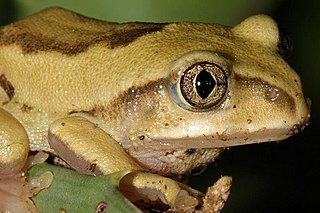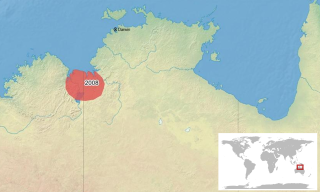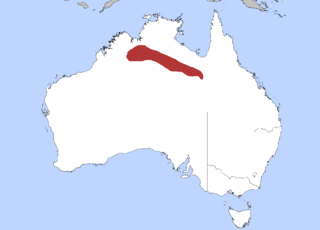Hyperolius mariae is a species of frog in the family Hyperoliidae. It is found in Democratic Republic of the Congo, Kenya, Tanzania, and Zambia. Its natural habitats are dry savanna, moist savanna, subtropical or tropical dry shrubland, subtropical or tropical moist shrubland, subtropical or tropical dry lowland grassland, subtropical or tropical seasonally wet or flooded lowland grassland, rivers, swamps, freshwater lakes, intermittent freshwater lakes, freshwater marshes, intermittent freshwater marshes, arable land, pastureland, rural gardens, urban areas, water storage areas, ponds, open excavations, irrigated land, seasonally flooded agricultural land, and canals and ditches.

Leptopelis mossambicus, the brown-backed tree frog, Mozambique tree frog or Mossambique forest treefrog, is a species of frog in the family Arthroleptidae found in Eswatini, Malawi, Mozambique, South Africa, Zimbabwe, and possibly Botswana. Its natural habitats are dry savanna, moist savanna, subtropical or tropical moist shrubland, subtropical or tropical dry lowland grasslands, subtropical or tropical seasonally wet or flooded lowland grasslands, swamps, freshwater marshes, and intermittent freshwater marshes. It is threatened by habitat loss.

Leptodactylus fuscus is a species of frog in the family Leptodactylidae. Its local names are rana picuda and rana silbador.
The Derby toadlet is a species of frog in the family Myobatrachidae. It is endemic to the Kimberley region near Derby and Broome in Western Australia. Its natural habitats are subtropical or tropical dry lowland grassland and intermittent freshwater marshes.

The northern toadlet is a species of frog in the family Myobatrachidae. It is endemic to Australia. Its natural habitats are subtropical or tropical dry shrubland, subtropical or tropical seasonally wet or flooded lowland grassland, intermittent rivers, and intermittent freshwater marshes.
The fat toadlet is a species of frog in the family Myobatrachidae. It is endemic to Australia. Its natural habitats are subtropical or tropical dry lowland grassland and intermittent freshwater marshes.
The glandular toadlet is a species of frog in the family Myobatrachidae. It is endemic to the arid coast near the Pilbara in Western Australia. Its natural habitats are subtropical or tropical dry lowland grassland, rivers, intermittent rivers, swamps, intermittent freshwater marshes, and canals and ditches.

The floodplain toadlet is a species of frog in the family Myobatrachidae.

The stonemason toadlet is a species of frog in the family Myobatrachidae. It is found in Australia, Papua New Guinea, and possibly Indonesia. Its natural habitats are dry savanna, moist savanna, subtropical or tropical dry lowland grassland, subtropical or tropical seasonally wet or flooded lowland grassland, intermittent rivers, intermittent freshwater lakes, and intermittent freshwater marshes.

The Tanami toadlet is a species of frog in the family Myobatrachidae. It is endemic to Australia. Its natural habitats are subtropical or tropical dry shrubland, subtropical or tropical dry lowland grassland, and intermittent freshwater marshes.

The mimic toadlet is a species of frog in the family Myobatrachidae. It is endemic to Australia. Its natural habitats are subtropical or tropical swamps, dry savanna, moist savanna, subtropical or tropical seasonally wet or flooded lowland grassland, intermittent freshwater lakes, and intermittent freshwater marshes.
The Russell's toadlet is a species of frog in the family Myobatrachidae. It is endemic to Australia. Its natural habitats are subtropical or tropical dry lowland grassland, intermittent rivers, freshwater marshes, intermittent freshwater marshes, and canals and ditches.

The blacksoil toadlet is a species of frog in the family Myobatrachidae. It is endemic to Australia. Its natural habitats are subtropical or tropical dry lowland grassland, subtropical or tropical seasonally wet or flooded lowland grassland, and intermittent freshwater marshes.

The Boettger's dainty frog or common caco is a species of frog in the family Pyxicephalidae. It is found in Botswana, Ethiopia, Kenya, Lesotho, Mozambique, Namibia, Rwanda, South Africa, Eswatini, Tanzania, Zambia, Zimbabwe, possibly Angola, and possibly Uganda. Its natural habitats are dry savanna, moist savanna, subtropical or tropical dry shrubland, subtropical or tropical moist shrubland, subtropical or tropical dry lowland grassland, subtropical or tropical seasonally wet or flooded lowland grassland, subtropical or tropical high-altitude grassland, swampland, intermittent freshwater lakes, intermittent freshwater marshes, arable land, pastureland, plantations, rural gardens, ponds, seasonally flooded agricultural land, and canals and ditches.

Müller's platanna, also known as Müller's clawed frog, is a species of frog in the family Pipidae found in Angola, Benin, Botswana, Burkina Faso, Cameroon, the Central African Republic, Chad, the Republic of the Congo, the Democratic Republic of the Congo, Ivory Coast, Eswatini, Ghana, Kenya, Malawi, Mozambique, Namibia, Nigeria, South Africa, Sudan, Tanzania, Togo, Uganda, Zambia, and Zimbabwe.
Peters' platanna is a species of frog in the family Pipidae found in Angola, Botswana, the Republic of the Congo, the Democratic Republic of the Congo, Gabon, Namibia, Zambia, Zimbabwe, and possibly Tanzania. Its natural habitats are subtropical or tropical moist lowland forests, dry savanna, moist savanna, subtropical or tropical dry shrubland, subtropical or tropical moist shrubland, subtropical or tropical dry lowland grassland, subtropical or tropical seasonally wet or flooded lowland grassland, subtropical or tropical high-altitude grassland, rivers, intermittent rivers, swamps, freshwater lakes, intermittent freshwater lakes, freshwater marshes, intermittent freshwater marshes, freshwater springs, arable land, pastureland, rural gardens, urban areas, heavily degraded former forests, water storage areas, ponds, open excavations, and canals and ditches.

The crowned bullfrog is a species of frog in the family Dicroglossidae. It is found in the Sub-Saharan Africa . Its natural habitats are subtropical or tropical moist lowland forest, dry savanna, moist savanna, subtropical or tropical dry shrubland, subtropical or tropical moist shrubland, subtropical or tropical dry lowland grassland, subtropical or tropical seasonally wet or flooded lowland grassland, rivers, intermittent rivers, freshwater lakes, intermittent freshwater lakes, freshwater marshes, intermittent freshwater marshes, freshwater springs, arable land, pastureland, rural gardens, heavily degraded former forest, and ponds.

Anchieta's ridged frog or plain grass frog is a species of frog in the family Ptychadenidae. It is found in Angola, Botswana, Republic of the Congo, Democratic Republic of the Congo, Djibouti, Eritrea, Ethiopia, Kenya, Malawi, Mozambique, Namibia, Somalia, South Africa, Sudan, Swaziland, Tanzania, Uganda, Zambia, Zimbabwe, possibly Burundi, and possibly Rwanda. Its natural habitats are subtropical or tropical moist lowland forest, subtropical or tropical moist montane forest, dry savanna, moist savanna, subtropical or tropical dry shrubland, subtropical or tropical moist shrubland, subtropical or tropical dry lowland grassland, rivers, intermittent rivers, freshwater lakes, freshwater marshes, intermittent freshwater marshes, hot deserts, arable land, rural gardens, urban areas, and ponds.

The Mascarene grass frog, or Mascarene ridged frog, is a species of frog in the family Ptychadenidae. It is found in sub-Saharan Africa, Madagascar, and Mauritius.

The Schilluk ridged frog is a species of frog in the family Ptychadenidae. It is found in Angola, Burkina Faso, Cameroon, Democratic Republic of the Congo, Egypt, Eritrea, Ethiopia, Ghana, Kenya, Malawi, Mozambique, Senegal, Somalia, Sudan, and Tanzania. Its natural habitats are dry savanna, moist savanna, subtropical or tropical dry shrubland, subtropical or tropical dry lowland grassland, subtropical or tropical seasonally wet or flooded lowland grassland, rivers, freshwater lakes, freshwater marshes, intermittent freshwater marshes, arable land, ponds, seasonally flooded agricultural land, and canals and ditches.














